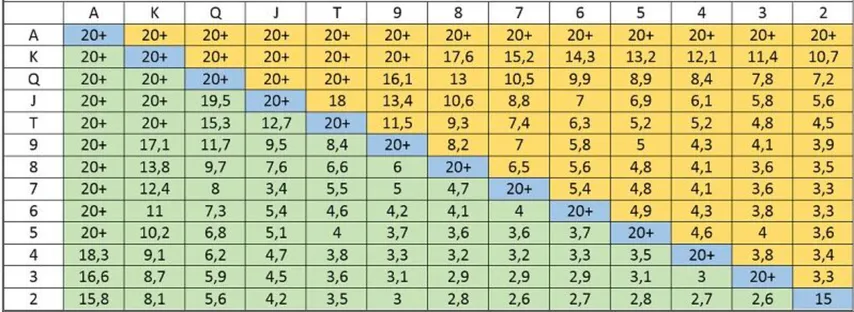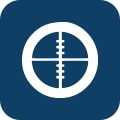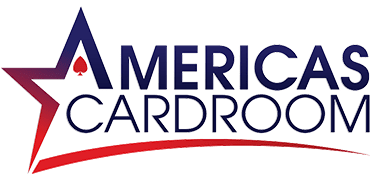Tournament poker is very different from cash games, in many ways. One of the most stark differences is the blind structure, which constantly changes, forcing players to accumulate chips. Everyone begins the tournament with deep stacks. You can lose five hands in a row and still have a decent amount.
But without any consistent wins, by the middle stages, the stack can shrink. At some point, the player is left with 10-20-30 blinds. With this kind of stack, virtuoso bluffs and complex plays with this stack size. At this stage, your stack allows you to make only two actions: push (all-in) or fold (pass). This is called push fold in poker.
We explain what is push or fold poker, with simple examples, charts, and ways to practice the concepts.

What Is Push-Fold in Poker?
A push-fold in poker is a situation where a player has a small stack. Planning small raises or chasing draws doesn’t make sense with such a low number of chips, so we adapt. Pushing or folding are the only two options available.
It is important to look at the blinds, not the absolute number of chips. For example, 25,000,000 in the stack at 10,000,000/20,000,000 is only 1.25 blinds (1.25 BB). The player will most likely be eliminated in a single hand.
A push-fold stack is generally considered to be less than 13-15 big blinds. In a broad sense, it can be up to 25 blinds.
When you play online, some online poker rooms allow you to switch how you view your stack size. You may choose to view the number of chips, but many players prefer to view their chips in BB.
- Increased first deposit bonus
- Increased rakeback and reloads
- Help with deposits and cashouts
- Access to private freerolls
- Round-the-clock support
What Is an Effective Stack in Poker?
One important factor in deciding on a hand is the effective stack size. This is the stack that will be involved in the hand and that the player is risking. Imagine a situation where player 1 goes all-in for 150 big blinds (150 BB). The opponent calls all-in for 20 big blinds (20 BB). To ensure equal terms, the pot will be 40 blinds.
Remember, each player will contribute the same amount of chips (20 big blinds). Even though one player has 150 big blinds, they can only use as many chips as the other player has (20 BB). The effective stack is the smallest stack among the players in the hand.
If there is one short stack at the table and the rest have 20-30 big blinds, take this into account. Most often, the effective stacks will be 20 to 30 big blinds. This excludes hands with a short stack, where the effective stack could be far lower.

What Is ICM?
ICM (Independent Chip Model) is a mathematical model you can apply to poker. It calculates stack value in the late stages of tournaments.
In cash games, the value of one chip is always fixed. In tournaments, it decreases over time. The difference in prize money can greatly affect optimal strategy. The same play that is ideal in cash games may be wrong in tournaments.
For example, shoving 33 into AK will be profitable long term. Players often call it a "coin flip". However, at the final table, such shoves are often best avoided. This is especially true with medium or larger stacks. You are increasing variance and may deprive yourself of a big win.
What Not to Do in Push-Fold
There are three things you should never do with push-fold stacks. This is especially true if you are not an experienced player.
1. Bluff. With a small push fold stack, forget that the word “bluff” exists. Only enter the hand with the hands listed below in the charts.
2. Call or limp to see the flop. You have less than 13 big blinds left. Spending 1 big blind to see the flop is an unaffordable luxury.
3. Raise 2.5x-3x. This is not justified. You are reducing your stack size if you lose. It will be difficult to resist continuing postflop. Why give opponents an extra chance to catch the flop and beat you with random cards? Go all in right away instead.
Push-Fold Starting Hand Charts
Starting hand charts (also called tables or matrices) are mathematically proven suggestions for playing a specific hand. They show different ranges of hands you can play or discard, from 23 offsuit to pocket Aces.
The only caveat is that each chart-maker has their own philosophy. Some may be too tight for you, others too loose. Choose classic charts (for example, according to Nash). Or create and select them with your coach. A chart found on the internet may not work correctly or lead to profitable play.
Nash starting hand charts are a basic strategy for playing hands based on stack size. These charts are suitable for beginners who need to learn simple poker concepts. They are not recommended for use at high limits. Such play can be easily exploited.


Note that in a vacuum with a pair of Deuces, calling all-in is recommended even with 15 big blind stacks. Against a classic push range, this will be profitable long-term. It's hard to disagree with the advantages of such a decision. However, things change at the final table of a major tournament. If there are 1 or 2 shorter stacks and prize money differs greatly, fold the Deuces.
Train Push Fold Concepts with Poker Tools
There are several styles of push fold strategy and certain programs can help you absorb them faster.
The best poker program for practicing late tournament decisions is ICMIZER 3. It is used by a great number of tournament poker players. It allows you to quickly get a clear answer to the main question: what action will be profitable in a particular hand?

The program calculates not only the probability of one hand winning over another. It also takes into account the current payout situation. This is a really useful program that tournament players must work hard with.
Train Push Fold Concepts for Free
Without practice, you won't master push-fold. Ideally, you could master various simulators like ICMIZER. Make 100 out of 100 correct decisions in training mode, playing flawlessly. However, nerves will make themselves known at the final table.
To avoid spending personal money on a deposit, there are several ways to practice for free:
- No deposit bonus of $88 from 888poker. This is a unique offer that only comes from 888 – no other poker room is this generous. After account verification, $8 is credited as tournament tickets. The remaining $80 is credited in equal parts of $10 for every 100 loyalty points earned.
- Free tournaments. The full schedule and current passwords for freerolls can be found in a special section on GipsyTeam.





























